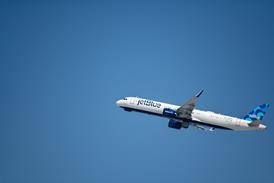Aerion reveals it has reopened the engine selection and airframe configuration in the past two weeks for its 12-seat supersonic jet, in a wide-ranging programme rebaseline almost nine years after launching the programme.
The process could result in Aerion dropping the supersonic variant of the Pratt & Whitney JT8D-219 as the propulsion system, and redefining the payload size and range of the aircraft, says chief technology officer Richard Tracy.
Aerion still thinks it can meet its pre-2020 target for entry into service, but Tracy admits the timing will be close.
The company is setting up meetings with engine suppliers General Electric, P&W and Rolls-Royce, revisiting certain concepts - such as a GE F110 derivative - or a clean-sheet supersonic derivative it considered more than a decade ago during the original engine selection process for the Aerion jet.
Aerion selected the low-bypass JT8D to power the twinjet because it was already certificated by the US Federal Aviation Administration and could reach the maximum speed target of Mach 1.6 with few modifications.
However, ICAO published a new standard for Stage 5 noise regulations earlier this year that would require Aerion to make more costly changes to the JT8D, Tracy says.
"Our awareness of the [regulations] and some of the other things are just making us realise we have to go back out and look," Tracy says.
Selecting a new engine, however, brings a new set of implications for the overall aircraft.
"This opens another Pandora's box, or maybe it's a treasure trove," Tracy says. The selection of the JT8D engine largely determined the Aerion aircraft's potential payload size and range. "Now we can look at other options," Tracy says.
Aerion officials are considering making the aircraft larger and introducing new variants, he adds. "Over the next few months, we'll have taken a first run at that. Then we'll be talking, making a decision on what those changes are, what engine, what configuration, and then we'll start really moving seriously into the development cycle."
Source: Flight Daily News























